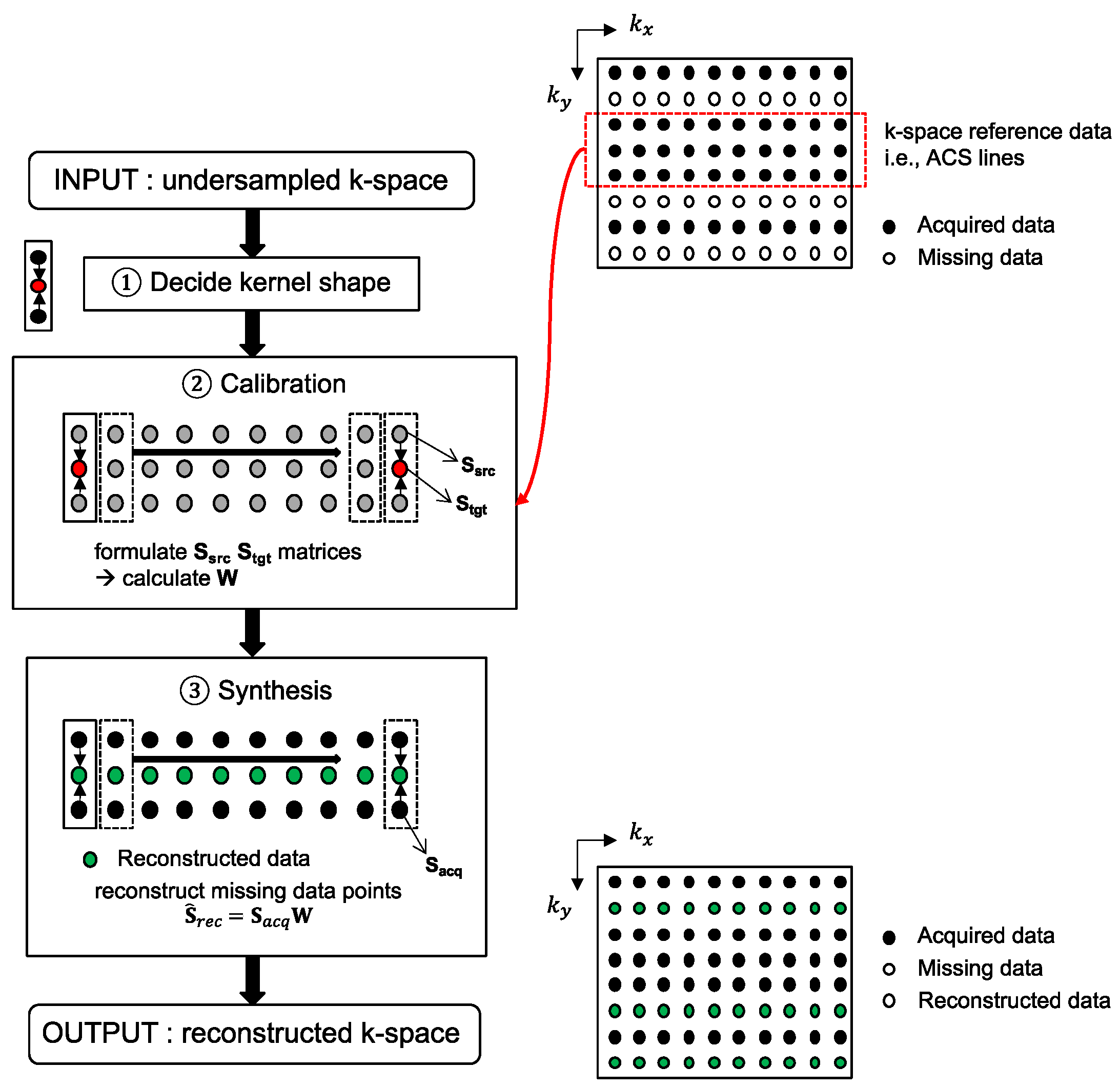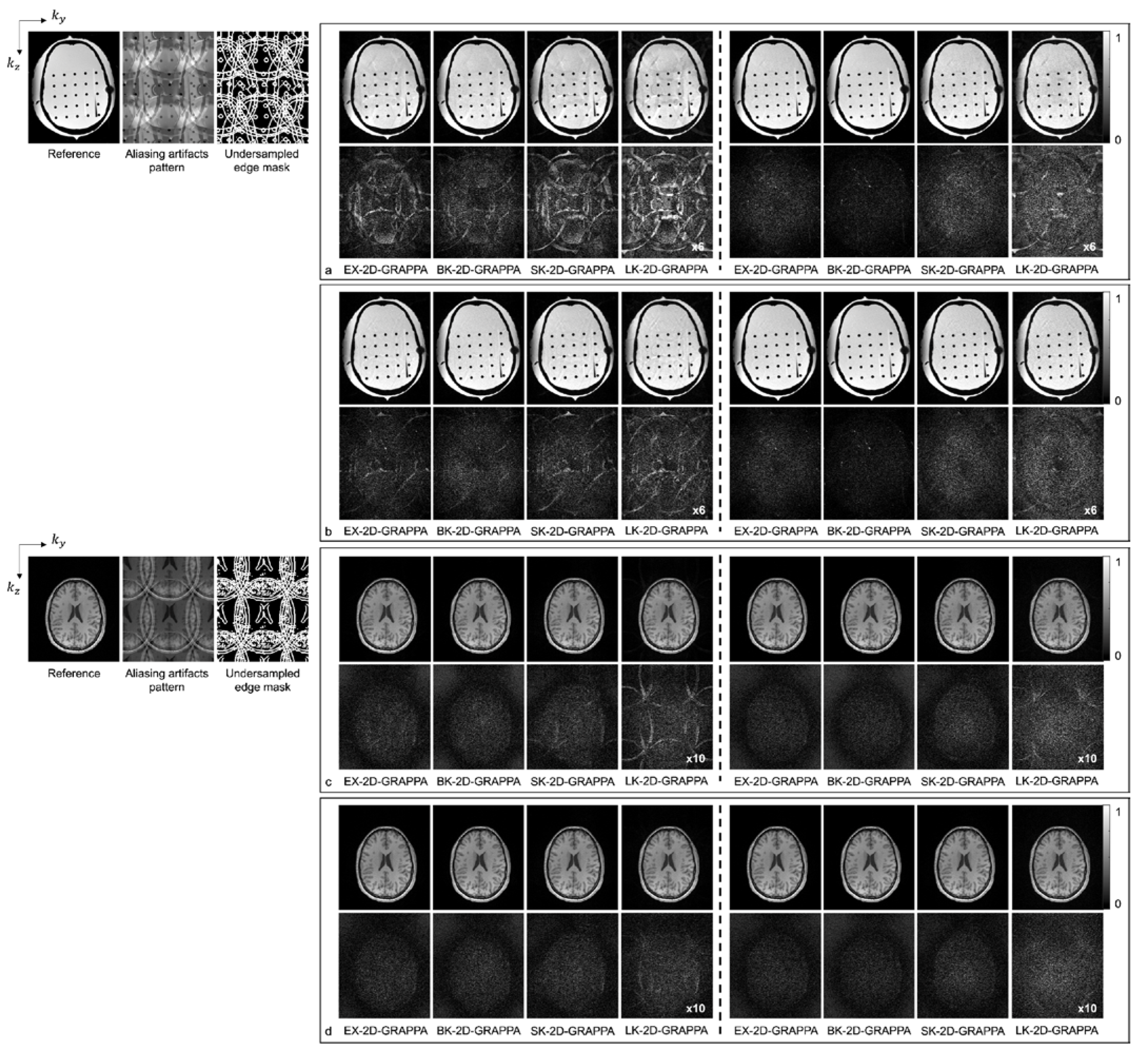A 2D-GRAPPA Algorithm with a Boomerang Kernel for 3D MRI Data Accelerated along Two Phase-Encoding Directions
Abstract
:1. Introduction
2. Related Works
3. Materials and Methods
3.1. Methods
3.1.1. 2D-GRAPPA Algorithm and Its Basic Kernels
3.1.2. The Lowest-Dimensional-Kernel (LK)-2D-GRAPPA Algorithm
3.1.3. The Extended-Kernel (EX)-2D-GRAPPA Algorithm
3.1.4. The Single-Kernel (SK)-2D-GRAPPA Algorithm
3.1.5. The Proposed Boomerang Kernel
3.2. Computer Simulations
3.3. MRI Data Acquisition
3.4. Quantitative Analyses
4. Results
5. Discussion
6. Conclusions
Author Contributions
Funding
Institutional Review Board Statement
Informed Consent Statement
Data Availability Statement
Conflicts of Interest
References
- Sodickson, D.K.; Manning, W.J. Simultaneous acquisition of spatial harmonics (SMASH): Fast imaging with radiofrequency coil arrays. Magn. Reson. Med. 1997, 38, 591–603. [Google Scholar] [CrossRef] [PubMed]
- Jakob, P.M.; Griswold, M.A.; Edelman, R.R.; Sodickson, D.K. AUTO-SMASH: A self-calibrating technique for SMASH imaging. Magn. Reson. Mater. Phys. Biol. Med. 1998, 7, 42–54. [Google Scholar] [CrossRef] [PubMed]
- Heidemann, R.M.; Griswold, M.A.; Haase, A.; Jakob, P.M. VD-AUTO-SMASH imaging. Magn. Reson. Med. 2001, 45, 1066–1074. [Google Scholar] [CrossRef] [PubMed]
- Griswold, M.A.; Jakob, P.M.; Nittka, M.; Goldfarb, J.W.; Haase, A. Partially parallel imaging with localized sensitivities (PILS). Magn. Reson. Med. 2000, 44, 602–609. [Google Scholar] [CrossRef] [PubMed]
- Blaimer, M.; Breuer, F.; Muller, M.; Heidemann, R.M.; Griswold, M.A.; Jakob, P.M. SMASH, SENSE, PILS, GRAPPA: How to choose the optimal method. Top. Magn. Reson. Imaging 2004, 15, 223–236. [Google Scholar] [CrossRef]
- Pruessmann, K.P.; Weiger, M.; Scheidegger, B.; Boesiger, P. SENSE: Sensitivity encoding for fast MRI. Magn. Reson. Med. 1999, 42, 952–962. [Google Scholar] [CrossRef]
- Griswold, M.A.; Jakob, P.M.; Heidemann, R.M.; Nittka, M.; Jellus, V.; Wang, J.; Kiefer, B.; Haase, A. Generalized autocalibrating partially parallel acquisitions (GRAPPA). Magn. Reson. Med. 2002, 47, 1202–1210. [Google Scholar] [CrossRef] [Green Version]
- Wang, Z.; Wang, J.; Detre, J.A. Improved Data Reconstruction Method for GRAPPA. Magn. Reson. Med. 2005, 54, 738–742. [Google Scholar] [CrossRef]
- Kim, D.; Jung, S.; Park, H.W. DRF-GRAPPA: A parallel MRI method with a direct reconstruction filter. J. Korean Phys. Soc. 2018, 73, 130–137. [Google Scholar] [CrossRef]
- Shin, P.J.; Larson, P.E.; Ohliger, M.A.; Elad, M.; Pauly, J.M.; Vigneron, D.B.; Lustig, M. Calibrationless parallel imaging reconstruction based on structured low-rank matrix completion. Magn. Reson. Med. 2014, 72, 959–970. [Google Scholar] [CrossRef]
- Haldar, J.P. Low-rank modeling of local k-space neighborhoods (LORAKS) for constrained MRI. IEEE Trans. Med. Imaging 2014, 33, 668–681. [Google Scholar] [CrossRef] [PubMed] [Green Version]
- Zhang, J.; Liu, C.; Moseley, M.E. Parallel reconstruction using null operations. Magn. Reson. Med. 2011, 66, 1241–1253. [Google Scholar] [CrossRef] [PubMed] [Green Version]
- Zhao, S.; Potter, L.C.; Ahmad, R. High-dimensional fast convolutional framework (HICU) for calibrationless MRI. Magn. Reson. Med. 2021, 86, 1212–1225. [Google Scholar] [CrossRef] [PubMed]
- Haldar, J.P.; Setsompop, K. Linear predictability in magnetic resonance imaging reconstruction: Leveraging shift-invariant Fourier structure for faster and better imaging. IEEE Signal Process. Mag. 2020, 37, 69–82. [Google Scholar] [CrossRef] [PubMed] [Green Version]
- Lustig, M.; Pauly, J.M. SPIRiT: Iterative self-consistent parallel imaging reconstruction from arbitrary k-space. Magn. Reson. Med. 2010, 64, 457–471. [Google Scholar] [CrossRef] [Green Version]
- Uecker, M.; Lai, P.; Murphy, M.J.; Virtue, P.; Elad, M.; Pauly, J.M.; Vasanawala, S.S.; Lustig, M. ESPIRiT—An eigenvalue approach to autocalibrating parallel MRI: Where SENSE meets GRAPPA. Magn. Reson. Med. 2014, 71, 990–1001. [Google Scholar] [CrossRef] [Green Version]
- Haldar, J.P.; Zhuo, J. P-LORAKS: Low-rank modeling of local k-space neighborhoods with parallel imaging data. Magn. Reson. Med. 2016, 75, 1499–1514. [Google Scholar] [CrossRef] [PubMed] [Green Version]
- Oh, C.H.; Kim, D.C.; Chung, J.Y.; Han, Y.; Park, H.W. A k-space-to-image reconstruction network for MRI using recurrent neural network. Med. Phys. 2021, 48, 193–203. [Google Scholar] [CrossRef] [PubMed]
- Oh, C.H.; Chung, J.Y.; Han, Y. An End-to-End Recurrent Neural Network for Radial MR Image Reconstruction. Sensors 2022, 22, 7277. [Google Scholar] [CrossRef]
- Knoll, F.; Hammernik, K.; Zhang, C.; Moeller, S.; Pock, T.; Sodickson, D.K.; Akcakaya, M. Deep-Learning Methods for Parallel Magnetic Resonance Imaging Reconstruction: A Survey of the Current Approaches, Trends, and Issues. IEEE Signal Process. Mag. 2020, 37, 128–140. [Google Scholar] [CrossRef]
- Weiger, M.; Pruessmann, K.; Boesiger, P. 2D SENSE for faster 3D MRI. Magn. Reson. Mater. Phys. Biol. Med. 2002, 14, 10–19. [Google Scholar] [CrossRef] [Green Version]
- Breuer, F.; Blaimer, M.; Müeller, M.F.; Seiberlich, M.; Heidemann, R.M.; Griswold, M.; Jakob, P.M. Controlled aliasing in parallel imaging (2D CAIPIRINHA). Magn. Reson. Med. 2006, 55, 549–556. [Google Scholar] [CrossRef] [PubMed]
- Deshmane, A.; Gulani, V.; Griswold, M.A.; Seiberlich, N. Parallel MR Imaging. J. Magn. Reson. Imaging 2012, 36, 55–72. [Google Scholar] [CrossRef] [PubMed] [Green Version]
- Lobos, R.A.; Haldar, J.P. On the shape of convolution kernels in MRI reconstruction: Rectangles versus ellipsoids. Magn. Reson. Med. 2022, 87, 2989–2996. [Google Scholar] [CrossRef]
- Blamier, M.; Breuer, F.A.; Mueller, M.; Seiberlich, N.; Ebel, D.; Heidemann, R.M.; Griswold, M.A.; Jakob, P.M. 2D-GRAPPA-Operator for Faster 3D Parallel MRI. Magn. Reson. Med. 2006, 56, 1359–1364. [Google Scholar] [CrossRef] [PubMed]
- Wang, Z.; Fernández-Seara, M.A. 2D partially parallel imaging with k-space surrounding neighbors-based data reconstruction. Magn. Reson. Med. 2006, 56, 1389–1396. [Google Scholar] [CrossRef]
- Shin, S.; Song, J.; Chung, J.; Han, Y. A comparison of volumetric GRAPPA algorithms for in-vivo MRI. In Proceedings of the SMRT 25th Annual Meeting, Singapore, 7 May 2016. [Google Scholar]
- Chung, J.; Kim, D.; Kang, D.; Kim, Y.; Ogawa, S.; Cho, Z. A comparison study of GRAPPA algorithms for volumetric parallel imaging. In Proceedings of the ESMRMB 2012, Lisbon, Portugal, 4 October 2012. [Google Scholar]
- Chung, J.; Kim, D.; Kang, D.; Kim, Y.; Ogawa, S.; Cho, Z. The effect of the kernel size in 3D-GRAPPA algorithms. In Proceedings of the ESMRMB 2012, Lisbon, Portugal, 4 October 2012. [Google Scholar]
- Brau, A.C.; Beatty, P.J.; Skare, S.; Bammer, R. Comparison of Reconstruction Accuracy and Efficiency among Autocalibrating Data-Driven Parallel Imging Methods. Magn. Reson. Med. 2008, 59, 382–394. [Google Scholar] [CrossRef] [Green Version]
- Ravishankar, S.; Bresler, Y. MR image reconstruction from highly undersampled k-space data by dictionary learning. IEEE Trans. Med. Imaging 2011, 30, 1028–1041. [Google Scholar] [CrossRef]
- Chang, Y.; Wang, H.; Zheng, Y.; Lin, H. Instrument Variables for Reducing Noise in Parallel MR Reconstruction. BioMed Res. Int. 2017, 2017, 9016826. [Google Scholar] [CrossRef] [Green Version]
- Heidemann, R.M.; Griswold, M.A.; Kiefer, B.; Nittka, M.; Wang, J.; Jellus, V.; Jakob, P.M. Resolution Enhancement in Lung 1H Imaging Using Parallel Imaging Methods. Magn. Reson. Med. 2003, 49, 391–394. [Google Scholar] [CrossRef]
- Nana, R.; Zhao, T.; Heberlein, K.; LaConte, S.M.; Hu, X. Cross-Validation-Based Kernel Support Selection for Improved GRAPPA Reconstruction. Magn. Reson. Med. 2008, 59, 819–825. [Google Scholar] [CrossRef] [PubMed]
- Weller, D.S. Accelerating Magnetic Resonance Imaging by Unifying Sparse Models and Multiple Receivers. Ph.D. Thesis, Massachusetts Institute of Technology, Cambridge, MA, USA, June 2012. [Google Scholar]









| # of Target and Source Data | Calibration Step | Synthesis Step | |||
|---|---|---|---|---|---|
| Matrix (Ssrc,Stgt) Formulation Number | Arithmetic Operation Number | Matrix (Sacq) Formation Number | Arithmetic Operation Number | ||
| Target: 1, source: nsrc | 3NfnsrcJ + NfJ | (nsrcJ)2(2Nf − 1) + nsrcJ2(2Nf + 2nsrcJ − 2) | NrecnsrcJ + nsrcJ2 | NrecJ(2nsrcJ − 1) | |
| Algorithms | # of target and source data | Calibration step | Synthesis step | ||
| Matrix (Ssrc,Stgt) formulation number | Arithmetic operation number | Matrix (Sacq) formation number | Arithmetic operation number | ||
| LK-2D-GRAPPA | Kernel 1—target: 1, source: 2 Kernel 2—target: 1, source: 2 Kernel 3—target: 1, source: 4 | (3 × 122 × 2 + 122) + (3 × 122 × 2 + 122) + (3 × 122 × 4 + 122) = 3688 | {(2 × 12)223 + (2 × 122)70} + {(2 × 12)223 + (2 × 122)70} + {(4 × 12)223 + (4 × 122)118} = 187,776 | (250,000 × 2 × 122 + 2 × 122) + (250,000 × 2 × 122 + 2 × 122) + (250,000 × 4 × 122 + 4 × 122) = 24,001,152 | 250,000 × 12 × 47 + 250,000 × 12 × 47 + 250,000 × 12 × 95 = 567,000,000 |
| EX-2D-GRAPPA | Kernel 1—target: 1, source: 6 Kernel 2—target: 1, source: 6 Kernel 3—target: 1, source: 4 | (3 × 122 × 6 + 122) + (3 × 122 × 6 + 122) + (3 × 122 × 4 + 122) = 7344 | {(6 × 12)223 + (6 × 122)70} + {(6 × 12)223 + (6 × 122)70} + {(4 × 12)223 + (4 × 122)118} = 480,384 | (250,000 × 6 × 122 + 6 × 122) + (250,000 × 6 × 122 + 6 × 122) + (250,000 × 4 × 122 + 4 × 122) = 48,002,304 | 250,000 × 12 × 143 + 250,000 × 12 × 143 + 250,000 × 12 × 95 = 1,143,000,000 |
| SK-2D-GRAPPA | Kernel 1—target: 3, source: 4 | (3 × 122 × 4 + 122) = 1872 | (4 × 12)223 + (3 × 4 × 122)118 = 256,896 | (250,000 × 4 × 122 + 4 × 122) = 12,000,576 | 3 × 250,000 × 12 × 95 = 885,000,000 |
| BK-2D-GRAPPA | Kernel 1—target: 3, source: 8 | (3 × 122 × 8 + 122) = 3600 | (8 × 12)223 + (3 × 8 × 122)214 = 951,552 | (250,000 × 8 × 122 + 8 × 122) = 24,001,152 | 3 × 250,000 × 12 × 191 = 1,719,000,000 |
Disclaimer/Publisher’s Note: The statements, opinions and data contained in all publications are solely those of the individual author(s) and contributor(s) and not of MDPI and/or the editor(s). MDPI and/or the editor(s) disclaim responsibility for any injury to people or property resulting from any ideas, methods, instructions or products referred to in the content. |
© 2022 by the authors. Licensee MDPI, Basel, Switzerland. This article is an open access article distributed under the terms and conditions of the Creative Commons Attribution (CC BY) license (https://creativecommons.org/licenses/by/4.0/).
Share and Cite
Shin, S.; Han, Y.; Chung, J.-Y. A 2D-GRAPPA Algorithm with a Boomerang Kernel for 3D MRI Data Accelerated along Two Phase-Encoding Directions. Sensors 2023, 23, 93. https://doi.org/10.3390/s23010093
Shin S, Han Y, Chung J-Y. A 2D-GRAPPA Algorithm with a Boomerang Kernel for 3D MRI Data Accelerated along Two Phase-Encoding Directions. Sensors. 2023; 23(1):93. https://doi.org/10.3390/s23010093
Chicago/Turabian StyleShin, Seonyeong, Yeji Han, and Jun-Young Chung. 2023. "A 2D-GRAPPA Algorithm with a Boomerang Kernel for 3D MRI Data Accelerated along Two Phase-Encoding Directions" Sensors 23, no. 1: 93. https://doi.org/10.3390/s23010093
APA StyleShin, S., Han, Y., & Chung, J.-Y. (2023). A 2D-GRAPPA Algorithm with a Boomerang Kernel for 3D MRI Data Accelerated along Two Phase-Encoding Directions. Sensors, 23(1), 93. https://doi.org/10.3390/s23010093







